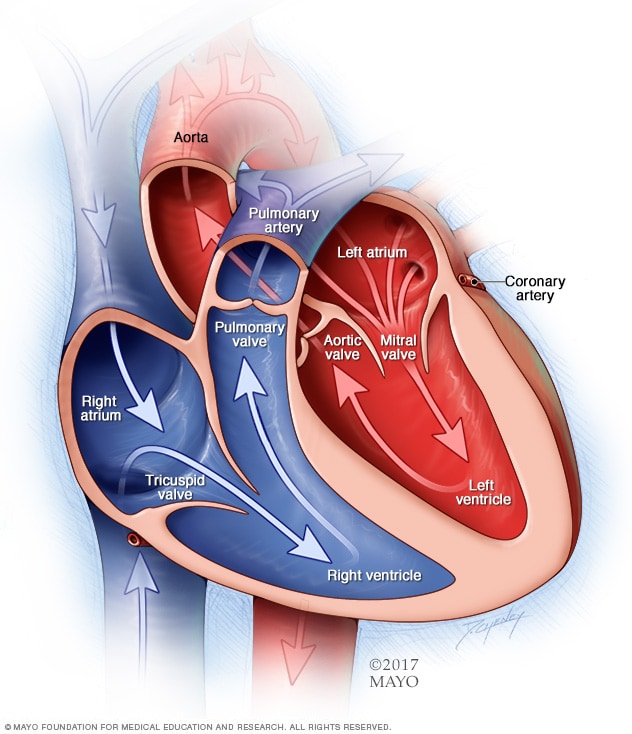Overview
Congenital heart disease is one or more problems with the heart's structure that exist since birth. Congenital means that you're born with the condition. Congenital heart disease in adults and children can change the way blood flows through the heart.
There are many different types of congenital heart defects. This article focuses on congenital heart disease in adults.
Some types of congenital heart disease may be mild. But complex defects may cause life-threatening complications. However, advances in diagnosis and treatment continue to improve survival for those with congenital heart disease.
People with congenital heart disease need lifelong medical care. Treatment may include regular checkups (watchful waiting), medications or surgery. If you have adult congenital heart disease, ask your health care provider how often you need a checkup.
Products & Services
Types
Symptoms
For some people, signs or symptoms of congenital heart disease aren't noticed until adulthood. Symptoms may return years after a congenital heart defect is treated.
Common congenital heart disease symptoms in adults include:
- Irregular heart rhythms (arrhythmias)
- Blue skin, lips and fingernails (cyanosis)
- Shortness of breath
- Feeling tired very quickly with activity
- Swelling of body tissue or organs (edema)
When to see a doctor
If you're having worrisome symptoms, such as chest pain or shortness of breath, seek emergency medical attention.
If you have signs or symptoms of congenital heart disease or were treated for a congenital heart defect as a child, make an appointment to see your health care provider.
Causes
Chambers and valves of the heart

Chambers and valves of the heart
A typical heart has two upper and two lower chambers. The upper chambers, the right and left atria, receive incoming blood. The lower chambers, the more muscular right and left ventricles, pump blood out of the heart. The heart valves, which keep blood flowing in the right direction, are gates at the chamber openings.
Researchers aren't sure what causes most types of congenital heart disease. Some congenital heart diseases are passed down through families (inherited).
To understand congenital heart disease, it helps to know how the heart typically works.
- The heart is divided into chambers — two upper chambers (atria) and two lower chambers (ventricles).
- The right side of the heart moves blood to the lungs through blood vessels (pulmonary arteries).
- In the lungs, blood picks up oxygen and then returns to the left side of your heart through the pulmonary veins.
- The left side of the heart then pumps the blood through the aorta and out to the rest of the body.
Congenital heart disease can affect any of these heart structures, including the arteries, valves, chambers and the wall of tissue that separates the chambers (septum).
Risk factors
Certain environmental and genetic risk factors might play a role in the development of congenital heart disease, including:
- Genetics. Congenital heart disease appears to run in families (inherited). It's associated with many genetic syndromes. For instance, children with Down syndrome often have congenital heart defects. Genetic testing can detect Down syndrome and some other genetic conditions while a baby is still in the mother's womb.
- German measles (rubella). Having rubella during pregnancy may affect how the baby's heart develops while in the womb.
- Diabetes. Having type 1 or type 2 diabetes during pregnancy also may affect a baby's heart development. Gestational diabetes generally doesn't increase the risk of congenital heart disease.
- Medications. Taking certain medications while pregnant can cause congenital heart disease and other birth defects. Medications linked to heart defects include lithium for bipolar disorder and isotretinoin (Claravis, Myorisan, others), which is used to treat acne. Always tell your health care provider about the medications you take.
- Alcohol. Drinking alcohol while pregnant has been linked to an increased risk of heart defects in the baby.
- Smoking. If you smoke, quit. Smoking during pregnancy increases the risk of congenital heart defects in the baby.
Complications
Congenital heart disease can contribute to other health concerns later in life. Complications may occur years after a congenital heart defect is treated.
Complications of congenital heart disease in adults include:
- Irregular heartbeats (arrhythmias). Faulty heart signaling causes the heart to beat too fast, too slowly or irregularly. In some people, severe arrhythmias may cause stroke or sudden cardiac death if not treated. Scar tissue in the heart from previous surgeries can contribute to this complication.
- Heart infection (endocarditis). Bacteria or other germs can enter the bloodstream and move to the inner lining of the heart (endocardium). Untreated, this infection can damage or destroy the heart valves or cause a stroke. If you are at high risk of endocarditis, your care provider may recommend taking antibiotics one hour before dental cleanings. Regular dental checkups are important. Healthy gums and teeth reduce the risk that bacteria will enter the bloodstream.
- Stroke. A congenital heart defect can allow a blood clot to pass through the heart and travel to the brain, where it reduces or blocks blood supply.
- High blood pressure in the lung arteries (pulmonary hypertension). Some congenital heart defects send more blood to the lungs, causing pressure to build. This eventually causes the heart muscle to weaken and sometimes to fail.
- Heart failure. Heart failure (congestive heart failure) means the heart can't pump enough blood to meet the body's needs.
Adult congenital heart disease and pregnancy
It may be possible to have a successful pregnancy with mild congenital heart disease. A care provider may tell you not to get pregnant if you have a complex congenital heart defect.
Before becoming pregnant, talk to your health care provider about the possible risks and complications. Together you can discuss and plan for any special care needed during pregnancy.
Prevention
Some types of congenital heart disease occur in families (inherited). If you have or someone in your family has congenital heart disease, screening by a genetic counselor may help determine the risk of certain heart defects in future children.